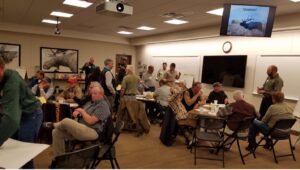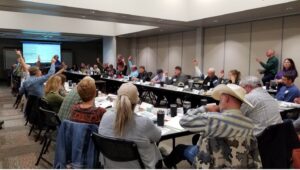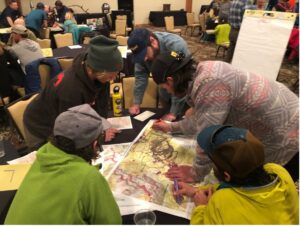By Jessica Western

As a facilitator living in Wyoming, I have experienced how collaborative problem solving has increasingly become a tool to unravel any tension and complexity arising between the public and the agencies that manage Federal lands. For example, the report recently put out by the US Forest Service, “Confronting the Wildfire Crisis: A Strategy for Protecting Communities and Improving Resilience in America’s Forests,” uses collaboration as a foundational tool, which is laudable. However, for the US Forest Service (and all agencies) to tackle huge subjects such as wildfire, climate change, chronic wasting disease, energy development, etc., there needs to be an equally thoughtful across-agency strategy to enable that collaboration. Because barriers remain, limiting the ability of federal natural resource agencies to engage in collaborative problem solving.
In this process, all relevant, often technical, information is shared and the public can ask a lot of tough questions, requiring time, money and commitment. The Federal Advisory Commission Act (FACA) muddies the waters regarding what federal agencies can and cannot do in relation to public engagement. Additionally, federal agency staff have their own personal values. These may not lend themselves to inclusivity of all stakeholders, sharing all information, and taking the time to go into detail about scientific and other types of complexities.
Get notified when new articles are posted to the EDR blog – sign up for our email list »

At a 2019 collaboration conference, I found many of the diverse participants, including federal agency staff members, had been stymied in their collaborative problem solving with(in) federal agencies. The conference was hosted by what was to become the Western Collaborative Conservation Network (WCCN).
As a result, we created the WCCN Public Policy Working Group. It consists of ranchers, other landowner types, federal agency professionals, environmental consultants, mining industry professionals, conservation advocates, academics and facilitators. The belief is that federal natural resource agencies can do more to enhance their collaborative problem-solving capacity. For two years, we worked to imagine what systemic change could look like, enhancing agency capacity for using collaborative problem solving.
We identified the following issues and recommendations.
Issue 1: Build Collaborative Capacity within Agencies.
When unit/agency leadership is not supportive of collaborative approaches for any of the reasons outlined above, there are consequences. A switch due to personnel reassignments can change the decisionmaker from one who is more collaboratively inclined to one who is less so. This upends the public process, disrupting – if not blocking – the work of a collaborative group. Trust suffers. And, even if a collaborative process is initiated, we have noted the possible lack of leadership support for employees’ collaborative work and for collaborative outcomes.
Recommendation 1: Institutionalize and Fund Collaboration as a Way of Doing Business.
We support agencies using collaboration and collaborative learning as a way of doing business, irrespective of personal preferences within an agency. These tools lend themselves well to multi-party consensus building and information sharing for complex issues. Still, they have limitations. Agency leadership and staff need to know when and how to use these tools, including within the restrictions of FACA (more on that below). This requires more rigorous training of leadership as well as staff in collaborative problem-solving, which in turn, requires funding.
Issue 2: Lack of Relationships and Trust at Local Levels.
Federal agency staff work assiduously to create relationships and trust at a local level. However, those same individuals move to different locations or are temporarily taking on assignments elsewhere, interrupting and sometimes completely upending collaborative efforts. This erodes relationships and the building of trust.
Recommendation 2: Support Professionalism in Place
Replace the “culture of mobility” with “professionalism in place.” Develop human-resource and management policies that allow personnel to move up the organization while becoming part of the community, through clear regulatory tools that balance local and national interests, allowing value to be created out of relationships and trust.
Issue 3: Lack of Social Capacity
We hear concerns from federal colleagues and partners regarding the lack of social capacity within their agency (i.e., social sciences, communication, and collaborative expertise). This equates to insufficient emotional intelligence, or the incapacity to be aware of, control, and express one’s emotions and empathetically handle interpersonal relationships. And yet, so much of what the agency does involves interaction with humans, including the many emotions and interests tied to how these lands are managed.
Recommendation 3: Build Social Capacity within Agencies.
If federal natural resource and land agencies want to better serve the American public and natural resources, agencies need to have the problem-solving skills to work with their constituents: Hire more human dimension expertise (people experienced in psychology, social psychology, communications, conflict resolution). Natural resource knowledge alone won’t carry the day. By far, most of the staff that the public interacts with possess little understanding of that one species: Homo sapiens.
Issue 4: Inconsistent Public Engagement Approaches
Issues and landscapes don’t end at any particular border; yet federal natural resource agencies differ in their capacity to engage the public on the same landscape. Although the WCCN Working Group acknowledges some agencies are taking steps to correct this, inconsistencies remain.
Recommendation 4: Create consistent collaborative capacity across all federal natural resource agencies.
Make true collaboration the standard approach: Define it, fund it, and train people. This needs to happen across all agencies, consistently. In order for this to succeed, we’ll need more federal funds.
Issue 5: Policies
The perception that the Federal Advisory Committee Act of 1972 (FACA) bars federal agencies from engaging in collaborative efforts.
Recommendation 5: Update Policies and Fund Agencies Adequately
Clarify and revise the Federal Advisory Committee Act. We recommend concentrating on the ultimate goal: reduce undue influence of a limited set of local interests at the expense of national interests, while allowing fair and open processes that include community needs. If agency leaderships use open and fair collaborative processes to find solutions or alternatives, with the clear stipulation that they are the decisionmakers, collaboration and collaboration-driven work on the ground will happen.

Professionals with federal agencies have talent and energy. Efforts such as the wildfire strategy mentioned above are commendable, and natural resource professionals and Western residents like us want to support our agencies. Yet, they often lack the collaborative problem-solving tools and funding needed to adequately meet the increasingly complex demands on public lands and natural resources. Without better tools, staffers will come up short finding robust solutions. This need for collaborative problem-solving tools and funding is intrinsically tied to thriving, resilient working landscapes, much of which is in public hands in the West.
The products of the WCCN Public Policy Working Group consist of a white paper, a one-pager, and a powerpoint that anyone can use to share the above issues and recommendations. It can be found here.
 Jessica M. Western, Ph.D., is Principal of Big Goose Creek Resolutions and Adjunct Professor/Research Associate with the University of Wyoming. Big Goose Creek Resolutions finds solutions to complex natural resource problems through social science and design and facilitation of collaborative public policy processes. Until recently Dr. Western was Senior Research Scientist in Human Dimensions in Natural Resources and Director of the Collaboration Program in Natural Resources in the Ruckelshaus Institute of the University of Wyoming. Recent and current collaborative processes she is/has lead address the Wyoming Game and Fish Department’s Chronic Wasting Disease Working Group, bighorn sheep and winter recreation on the Teton Range and OHV use and forest plan revision on the Black Hills National Forest. She also is creating and providing basic and advanced collaboration training to USFS Region 2’s Forests. Dr. Western is a peer-reviewed social psychologist specializing in the relationship between people and natural resources. She teaches natural resource policy in relation to the United States and the European Union at the University of Wyoming.
Jessica M. Western, Ph.D., is Principal of Big Goose Creek Resolutions and Adjunct Professor/Research Associate with the University of Wyoming. Big Goose Creek Resolutions finds solutions to complex natural resource problems through social science and design and facilitation of collaborative public policy processes. Until recently Dr. Western was Senior Research Scientist in Human Dimensions in Natural Resources and Director of the Collaboration Program in Natural Resources in the Ruckelshaus Institute of the University of Wyoming. Recent and current collaborative processes she is/has lead address the Wyoming Game and Fish Department’s Chronic Wasting Disease Working Group, bighorn sheep and winter recreation on the Teton Range and OHV use and forest plan revision on the Black Hills National Forest. She also is creating and providing basic and advanced collaboration training to USFS Region 2’s Forests. Dr. Western is a peer-reviewed social psychologist specializing in the relationship between people and natural resources. She teaches natural resource policy in relation to the United States and the European Union at the University of Wyoming.
